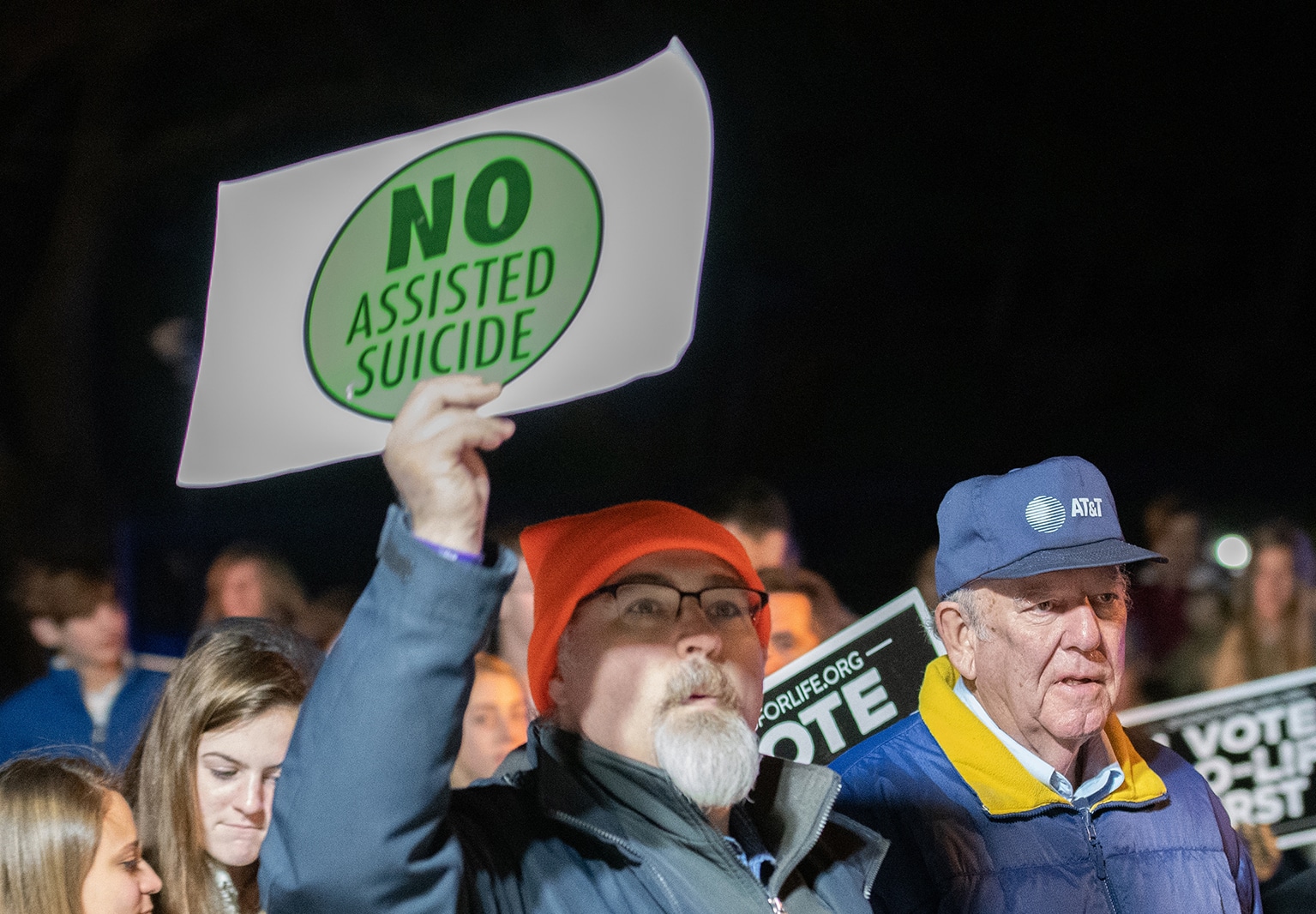(OSV News) — When California in 2021 relaxed its physician-assisted death rules — easing access to the lethal means for residents to take their own lives — several lawmakers behind the change cited a desire to aid the terminally ill, invoking a sort of legislative altruism.
The result — profiled in the California Department of Public Health’s “End of Life Option Act 2022 Data Report,” released this July — was a 63% increase in requests for life-ending drugs, and 853 eventual deaths.
But it’s not simply the higher statistics that concern Catholic ethicists, advocates and doctors. It’s the acceleration of trends contributing to a cultural — and potentially medical — shift away from the preservation of life.
Life is worth living
“Legalizing physician-assisted suicide is just the first step of putting into law the lie that there is such a thing as a life not worth living,” said Father Tad Pacholczyk, senior ethicist at the National Catholic Bioethics Center.
“By branding the sick or disabled in this way, we soon find ourselves ‘haggling over the price.’ How much disability or sickness should be enough to qualify someone for elimination? How much imperfection is allowable on this slippery slope?” Father Pacholczyk questioned. “Instead of tempting patients to commit suicide, we should extend true compassion and ongoing support to the disabled or the dying.”
He said, “So much can be done to help people who are helpless or feeling helpless. If patients are in pain, we ought to eliminate the pain, not the patient.”
The U.S. Conference of Catholic Bishops’ Secretariat of Pro-Life Activities notes in a fact sheet, “Assisted suicide is a deadly mix with our profit-driven health care system.”
The term physician-assisted death is an umbrella term that includes both physician-assisted suicide and physician-assisted euthanasia. In physician-assisted suicide, a physician prescribes lethal medication but the patient administers the medication. In physician-assisted euthanasia, the physician administers the medication prescribed to kill the patient.
Where is physician-assisted suicide legal?
Currently, nine states — California, Colorado, Hawaii, Maine, New Jersey, New Mexico, Oregon, Vermont and Washington — and the District of Columbia have enacted “medical aid in dying” laws allowing physician-assisted suicide. In Montana, the provision is legal via a court ruling that is challenged with each legislative session.
Another three states — Massachusetts, New York and Pennsylvania — have their own “medical aid in dying” bills pending.
In all, 40 states consider physician-assisted suicide illegal, while the federal government and all 50 states prohibit euthanasia as homicide.
| How does a person convince someone not to take their life through physician-assisted death? |
|---|
|
“What I tried to do,” said Jesuit Father Myles Sheehan, a doctor and director of the Pellegrino Center for Clinical Bioethics at Georgetown University in Washington, “was not to get too much into existential questions, but really try to use myself and my care team in a sort of a therapeutic effort — to convince people that we would treat their pain aggressively.” Misconceptions, Father Sheehan told OSV News, can impact patient choices. “People have inaccurate ideas as to the ability of palliative care or hospice to provide good pain relief,” he said. “Not every symptom can be completely relieved — but pain, we’re really pretty good at, in most cases.” Those perhaps most vulnerable are patients without connections. “There are ways in which people with serious illness who don’t have extended networks could receive assistance,” Father Sheehan said. “But that’s expensive and hard … So it may seem ‘easier’ not to stay alive in those situations. But that represents a failing of our society.” |
Worldwide, an estimated 200 million people live in jurisdictions with some legalized form of medically-assisted dying.
Waiting period shortened from 15 days to 48 hours
California’s End of Life Option Act initially took effect in 2016. At the time, it contained a restriction: patients with terminal illnesses were required to officially make two oral requests for life-ending medications, 15 days apart. In 2021, however, a bill to change this and other restrictions was introduced and enacted.
When the revised law went into effect Jan. 1, 2022, California’s waiting period to receive prescribed lethal drugs was shortened to just 48 hours.
Between 2016-2022, 5,168 people were prescribed lethal medication under the law, with ultimately 3,349 individuals, or 64.8%, ingesting the lethal drugs and dying.
“Despite the tragic rising numbers in California, one observation is the astounding cause for hope that proportionally so few people seek this, even though encouraged by the state,” William Mattison, a theology professor at the University of Notre Dame in South Bend, Indiana, told OSV News. “And an even smaller percentage actually go through with it. One is too many of course, but there’s a beautiful sign there about human resilience and the desire to live.”
Who is choosing it?
The California Catholic Conference, however, is concerned that the officially reported numbers may not give an accurate picture of legalized physician-assisted suicide’s overall impact.
“The data on the End of Life Option Act in California shows that it is overwhelmingly used by a very narrow slice of the population: elderly white, college-educated, well-insured men,” Kathleen Domingo, CCC executive director, told OSV News.
However, noting California’s population diversity, Domingo observed, “In no other sector of our state — in no other program — is there ever an instance where only this narrow part of the population is represented. It definitely sends red flags.”
In response, the conference is “working with a broad coalition of people concerned with disability rights, care for the elderly and support for Latino families to ask the California Department of Public Health for greater transparency with data collection and data reporting,” Domingo said. “We want to make sure we know how the law is working and what opportunities there are for greater safeguards for vulnerable communities.”
Father Pacholczyk urged a similar caution.
“Members of the disabled community see the handwriting on the wall, and sense the escalating pressure to make an early exit,” he explained. “The smoke signals emanating from long-respected institutions like professional medical societies, health care systems, insurance companies and the courts suggest that the evening twilight is poised to give way to the darkness,” said Father Pacholczyk.
Never an act of mercy
In the U.S. Catholic bishops’ 1998 statement “Living the Gospel of Life: A Challenge to American Catholics,” the bishops explained that “euthanasia and assisted suicide are never acceptable acts of mercy. They always gravely exploit the suffering and desperate, extinguishing life in the name of the ‘quality of life’ itself.”
The Catechism of the Catholic Church teaches that suicide and euthanasia are morally unacceptable, but it distinguishes these acts from morally legitimate choices to discontinue “medical procedures that are burdensome, dangerous, extraordinary, or disproportionate to the expected outcome. … Here one does not will to cause death; one’s inability to impede it is merely accepted.”
David Elliot, assistant professor of moral theology and ethics at The Catholic University of America in Washington, told OSV News the concerns of disability advocates are “perfectly well-founded.”
“Some of them actually said almost every issue that comes up as justifying assisted suicide is ultimately a disability issue — reduced health; reduced physical autonomy,” he explained. “They’ve said those aren’t disability issues; are you saying the disabled life is not worth living?”
Elliot demonstrated his point with an hypothetical example.
“If a younger, healthier person asks for assisted suicide, the state in effect says, ‘No, you’re wrong to think your life isn’t worth living,'” he said. “But if somebody older, very sick, physically debilitated asks for it, the state in effect says, ‘You’re rational to think your life is not worth living — and we’ll help you end it.'”
The state of Oregon, Elliot recalled, previously conducted a sort of “exit interview” for those who were about to take their lives through physician-assisted death.
“Of the actual motivations that people referred to — physical pain was surprisingly low on the list,” Elliot shared.
“There’s a kind of curious irony in the fact that we had all these centuries where nobody thought for a second about institutionalizing the possibility of suicide,” he observed. “But now when we’ve got the best pain control, pain relief, and medical technology in human history — suddenly, people are speaking of unbearable suffering.”





